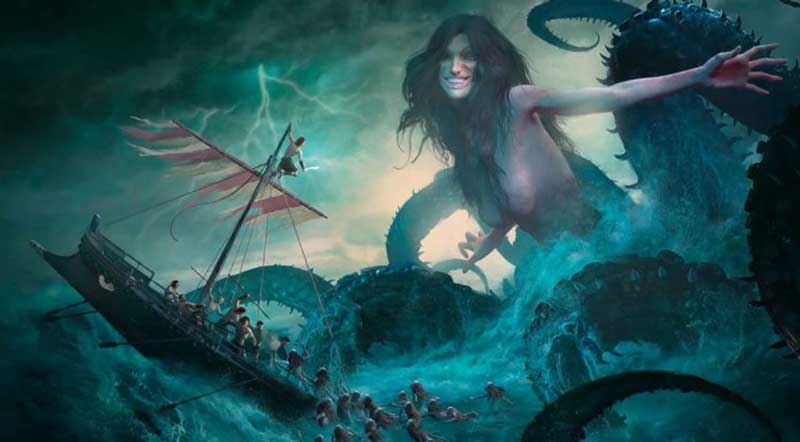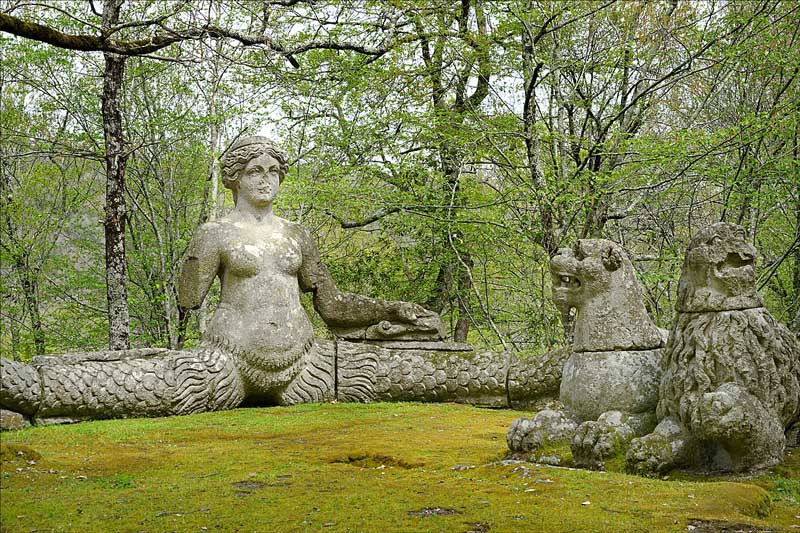
In Greek mythology, Echidna was a Drakaina, a monstrous she-dragon with the head and breasts of a woman and the tail of a coiling serpent. While sometimes she was equated with Python, a deadly dragon born of stinking mud left behind by the great Deluge, she was also named the Tartarean lamprey and placed her in the dark, swampy pit of Tartaros, the deepest region of the world. Although Echidna is said to be the daughter of Phorcys, the primordial sea god, and Celo, the personification of the dangers of the deep, according to the ancient Greek poet Hesiod, she was born to Tartarus of the Underworld and Gia, the personification of the Earth.
Echidna was depicted by Hesiod as an attractive and irresistible half nymph with beautiful black eyes, fair cheeks, and long hair, while her other half is a huge monstrous serpent’s body with a single or double tail. She was also described as bloodthirsty and the destruction of men. Typhon, the multi-headed monstrous storm giant, with eyes made of fire, and later came to be known as the father of all monsters, joined in love to Echidna with glancing eyes to produce fierce offspring. However, they were related as brother and sister as both of them were the children of Gia and Tartarus. Together they spawned a host of terrifying monsters to plague the earth, including the multi-headed infernal hounds guarding the gates of Hades, along with Cerberus and Orthus; Hydra, the multi-headed serpent who, when one of its heads was cut off, grew two more; the fire-breathing hybrid of goat, lion and a serpent; the Sphinx, a monster with the head of a woman and the body of a winged lion; the Nemean lion, killed by Heracles as his first labor; and Ladon, the dragon who guarded the Golden Apples in Garden of the Hesperides, the nymphs of the evening and golden light of sunsets.

According to the folklore of a region on the southern coast of the Black Sea, while Heracles visited Erytheia to obtain the cattle of Geryon, the monster with three heads, as his tenth labor, one morning he awoke to find his horses missing. In the process of searching his horses, he suddenly discovered a half maiden and half serpent creature in a cave. Though the name of the creature was not clearly mentioned, in every possibility, she was Echidna. She said that his horses are under her custody, and she would release them only if Heracles would have sex with her. Heracles agreed and she had three sons with him, namely Agathyrsus, Gelonus, and Scythes.
While Homer depicted the cave of Echidna as the Arima, the couch of Typhyoeus, according to Hesiod, she lived with Typhon in a cave in the country of the Arimi. However, the Greeks on the Euxine conceived her to have lived in Scythia, and she challenged Zeus to the throne of heaven. It is said that over time, Echidna blamed Zeus for the untimely deaths of her children, and finally, the couple attacked the Olympians, challenging Zeus to the throne. As they rampaged their way towards Mount Olympus, the gods and goddesses became apprehensive, and most of them fled from their palaces. Aphrodite was said to have transformed herself into a fish to escape. Many of the deities took sanctuary in Egypt, and they continued to be worshipped in their Egyptian forms. However, Zeus stayed there to meet the threat to his throne, and occasionally it was said that Nike and Athena stayed by his side.

During the epic fight between Typhon and Zeus, Zeus once required help from Athena to tie back his tendons and muscles to enable him to continue the fight. Eventually, he defeated Typhon and Echidna with his thunderbolt. While Typhon was sealed beneath the Mount, Zeus mercifully allowed Echidna and her children to live in Arima as a challenge to the future Heroes. However, Hera had her doubts about Echidna, and she did not approve of her husband’s decision to let her live. She, therefore, commissioned her obedient servant to kill Echidna, and although Hesiod depicted Echidna as an immortal and ageless nymph, according to Apollodorus, she was finally killed in her cave while she was sleeping by Hera’s servant Argus Panoptes, the hundred eyed giant.
